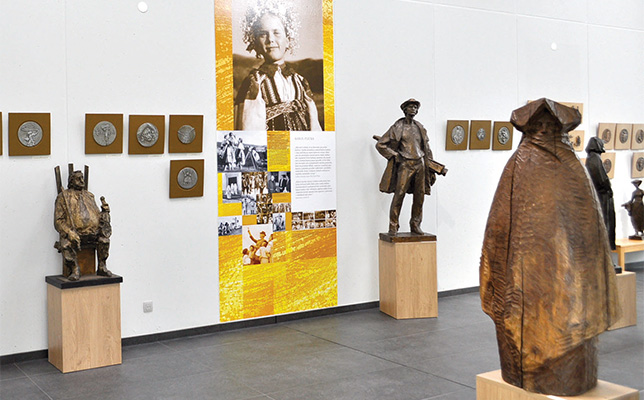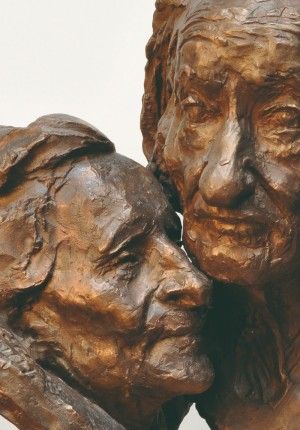Symbols of Folk Culture
Exposition in GJK in the period May 2019 - October 2019
In 2019, the fifth thematic area of the work of the National Artist Ján Kulich, entitled Symbols of Folk Culture, was presented to the public. Ján Kulich was literally entwined with folk culture, music and dance, and he had experienced all the phenomena, expressions, traditions and customs in his family since childhood. It was a natural part of his life so he, as a beginning artist (and still a child), naturally brought it into his first works.
Detail
EXPOSITION PERIOD
May 2019 - October 2019
NUMBER OF EXHIBITED WORKS
64 sculptures, 76 medals, 25 reliefs
The central point of the exhibition was the Jánošík theme, while its intellectual content carried a symbolic meaning. The theme of the national hero Juraj Jánošík has accompanied Ján Kulich in his work since his earliest childhood and he has dealt with it all his life, in every creative stage.
A strong motif in Kulich's work is also the tradition of carrying out Morena(vynášanie Moreny) which was processed in various techniques, materials and genres. The highlight is a masterpiece - a statue of a girl with Morena, created using welded iron technology. The viewer does not have to be an expert to be able to appreciate the genius of Kulich's talent in this (and not only in this) work.
The statue of Bell Master (Zvončiar) was also exhibited, created by this technology, with which some visitors already had the opportunity to get acquainted.
The collection included works inspired by folk traditions, folklore and by figural portraits of the most important personalities of folk culture, who had since become legends. The motifs processed in free sculptures, reliefs and medals are connected by internal ties to this thematic-ideological sphere, related to the homeland and the idea of life in the wild, which evokes feelings of freedom.
For the first time, a unique work from the early, student times of Ján Kulich - his Shepherd Axe (Valaška) from 1950 - was exhibited in the gallery.
The shepherd‘s axe became a symbol of the legendary mountain outlaws, the resistance and rebellion of serf people. The young Kulich, then a 20-year-old student, created with great enthusiasm a unique work with carved reliefs on the steel part of the axe and with decorative ornaments of embossed copper and silver on the handle,
In the 20th century, shepherd‘s axe retained only a symbolic or memorial function. In addition to the belt and hat, it became a sign of the rank for the head shepherd. He always wore it when he went among the people but especially during the beginning and the end of the sheep herding season.
An important part of the exhibition was also Kulich's figural portrait of Karol Plicka, on the occasion of his 125th birth anniversary. Plicka was a Czech ethnographer and musicologist and thanks to his work we have preserved the authentic form of folk culture in Slovakia from the beginning of the 20th century.
He wrote lyrics and melodies of Slovak and Czech folk songs, collected fairy tales, children's games, sayings, pictures, photographed our ancestors, costumes, folk architecture, nature and other treasures of the folk culture of Slovakia, which was gradually expelled by civilization.
The personalities and motifs captured by Karol Plicka's camera became a source of inspiration for many of Ján Kulich's works. The exhibition was complemented by the large-scale graphics that well documented Karol Plicka‘s work.
In 2019, an untraditionally accompanying exhibition of another thematic area from the work of Ján Kulich was included on the occasion of the 75th anniversary of the SNU and was installed on the upper floor of the gallery.
Needless to say, Ján Kulich is the author of several SNU memorials in Slovakia; let us mention the memorial in Zvolen – Shepherd’s axe (Valaška), the memorial in Bratislava on the Old Town square, in Partizánske, as well as his very first SNU memorial from 1954 in Dolný Harmanec.
In addition to monumental works with this theme, he is also the author of many exceptional medals, which have won awards at home and abroad and which visitors had the opportunity to see in the gallery in Zvolenská Slatina.

" With his contribution to the artistic grasp of phenomena and expressions of traditions, Kulich, in my evaluation, belongs to the same stream as Martin Benka, Karol Plicka, Martin Martinček. His work in this field is monumental. Though for many, especially of the younger generation, it is unknown. If preserved in its entirety, it will be a rare and important testimony of a culture that is disappearing, just as the culture of the Maori in Oceania is disappearing. To understand what is disappearing and what we have lost, we need to learn to recognize it. "


" Ján Kulich participates with his tolerant free form plaque creation in order to break the former academic character and official purpose of this type of sculpture out of a narrow representative framework, to become a living testimony about the people of our times."


"He brought the wealth of humanity into his work and thus created works of timeless significance, filled with the philosophy of today. He was so faithful to himself that nothing could divert him from the path he had taken in his youth"












